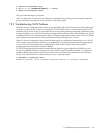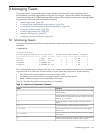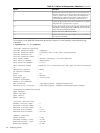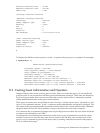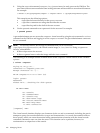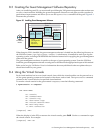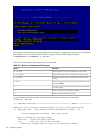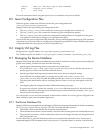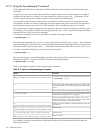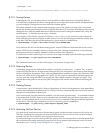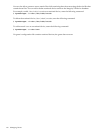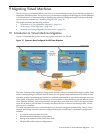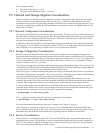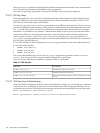TOPics - Show all vMP Help topics and commands
HElp - Display this screen
Q - Quit help
For more information about using the hpvmconsole command, see hpvmconsole(1M).
8.5 Guest Configuration Files
When the guest is created, the VM Host creates the guest configuration file
/var/opt/hpvm/guests/guestname.
Integrity VM creates up to three guest configuration files:
• The vmm_config.current file contains the current guest configuration currently set.
• The vmm_config.prev file contains the last known guest configuration settings.
• The vmm_config.next file contains the configuration settings that have changed since the guest
was started. To initiate these changes, you must reboot the guest.
Never modify the guest configuration files manually. Always use the appropriate Integrity VM command
(hpvmmodify or hpvmdevmgmt) to modify guest configuration parameters. Directly modifying the guest
configuration files can cause guests to fail in unexpected ways.
8.6 Integrity VM Log Files
Each guest has a log file named /var/opt/hpvm/guests/guestname/log.
The VM Host log files are stored as /var/opt/hpvm/common/command.log and hpvm_mon_log.
8.7 Managing the Device Database
Integrity VM cannotdetect all potential backing storeconflicts, and does not always prevent misconfigured
guests from booting. Conflicts can arise from the following:
• Specifying the same backing store for more than one virtual device.
If you add disk:scsi::disk:/dev/rdsk/c0t1d2 for Guest A, do not add the same device to
another guest or to the list of VM Host restricted devices.
• Specifying multiple backing store parameters that lead to the same physical storage.
If the VM Host has multiple paths to a storage device, like /dev/rdsk/c3t2d0 and
/dev/rdsk/c4t2d0, only one path should be specified for a disk:scsi or dvd:scsi in Guest A.
The other path should not be used as a backing store by Guest A or by any other guest or the VM
Host.
• Overlapping physical storage allocated for different backing store types.
If a guest uses a logical volume (for example, rlvol1) as a backing store device, the disks or disk
partitions used by the volume group onwhich the logical volume ismade (for example, /dev/vg01)
cannot be used as backing stores.
You can use the ioscan and sam commands to detect these conflicts. If you force guests configured with
these conflicts to start, data corruption might occur.
8.7.1 The Device Database File
Integrity VM devicemanagement stored Integrity VMdevice mapping information in thedevice database
file (/var/opt/common/hpvm_mgmtdb). This file is divided into three sections:
• The header, which states that the file should not be hand-edited
• The restricted device section, whichcontains a list of host devices that guestsare not allowed to access
• The guest devices section, which contains those devices, both storage and network, that guests have
been configured to use
Do not edit the hpvm_mgmtdb file directly unless you are specifically advised to do so. Always use a
supported Integrity VM commands (such as hpvmmodify or hpvmdevmgmt) to modify virtual devices.
8.5 Guest Configuration Files 107



